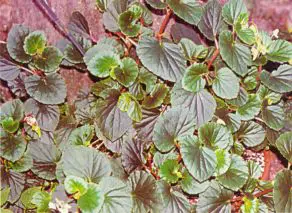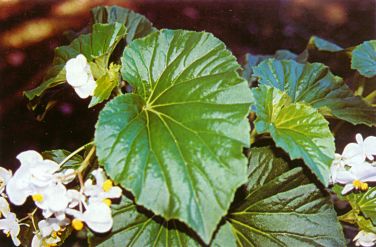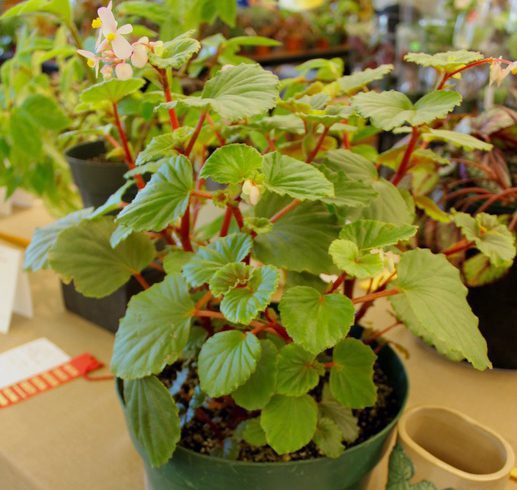I’ve never seen a B. fischeri win a Division Award at a show, nor appear as a beauty in any magazine, but this is one plant that really should be on everyone’s list of favorites.
B. fischeri first came to me as an ABS seed find packet of seed labeled simply “Species Semp” I grew these out some years ago in Ozone and was enchanted with their ease and speed of growth. I had pots and pots of them from that small seed packet, but I couldn’t locate any species name and description to fit them among the Semperflorens listed in any of my reference books. Then, on the tour to Galveston’s Moody Gardens during the 1997 Houston ABS Convention, I spotted the plant growing there. California growers on the tour identified it to me as B. fischeri. Later, Thelma O’Reilly confirmed for me that was indeed my plant’s name also. Not a Semperflorens species at all, but a Shrub-like.
It is listed there among the Bare-leaved, small leaved (generally under 4 inches at maturity). Surprisingly, it is not included on the list of recommended Shrub-like plants for beginners in the Thompson book, Begonias The Complete Reference Guide (New York, Times Books, 1981), but I would recommend it to every grower.
When it grew, bloomed and set seed with such ease in Ozone, AR (at 2000′, summer temperatures rarely above 90 F), I thought perhaps it was of mountain origin and liked it cool. But then I discovered it grew even better, getting larger leaves and taller, heavier stems in the Nacogdoches heat and humidity. There in Nacogdoches, I found a huge one growing on a lady’s patio in a big pot. She couldn’t identify it, but she assured me that it rarely froze down and if it did, it came back each spring. (Temperatures were in the 20° F range several times last winter).
In Houston then, visiting gardens there I saw it growing in the ground and looking great.
Although listed as Shrub-like, it is certainly everblooming, slowing down only in the hottest or coldest weather. The large one in the photo below, grown in Nacogdoches, stayed outside all winter, coming into the garage only during the spells of 20°. It never stopped blooming.
Thompson lists it as blooming bright pink in Spring, and my plant in Ozone which received sun for much of the day did have pink blooms, but in a shadier location in Nacogdoches they were white as the photos show.
Why do I like it? Because it ‘ is both hardy and beautiful. As I mention in the Editor’s Notes, most begonias moving from Nacogdoches to Stillwater suffered drastically – not so B. fischeri. Its leaves remain crisp and clear and the blooms never stopped. Although it grows rapidly and makes a large plant in less than a year, it has been long lived for me although it has to be pruned back regularly and severely. These stem cuttings root easily and quickly make a nice gift or sale plant.
Best of all for me, a seed lover, it produces seed like a small factory. It has 34 chromosomes and is a good candidate for hybridizing with most Semps. In fact, I feel sure many Semp hybrids have B. fischeri in their background. My favorite cross has been with B. mollicaulis as the female parent. This has yielded the plant shown below on the opposite page which I have named B. ‘Dovecot’. It has white flowers, but several of the seedlings have pink flowers. There is also a bronze leaved version that I have named B. ‘Central Market’. The green version has very large leaves, up to 8 to 10″, but the bronze leaved one leaves are smaller at about 6 inches.
Since making this cross, I have seen another begonia on the market in Baton Rouge whose name I forget with pink flowers that looks very much like the version I produced with pink flowers.
I have never had any disease problem on B. fischeri, but B. ‘Dovecot’ did get mildew after the move although it never had in Nacogdoches. This was easily cleared up with a fungicide. The bronze leaved version did not get mildew.
Thompson lists the home country as Brazil, but other sources indicate it is to be found over much of South and Central America. Doorenbos, et. al. (The Sections of Begonia, The Netherlands, WagenigenAgficultural University, 1998) places it in the section Begonia in which there are 62 species, many of which are horticulturally classed as Semps, including B. cucullata, B. schmidtiana, and B. subvillosa. B. fischerihas 4 male tepals and 5 female. The ovary has 3 unequal wings.
There is also a B. fischeri var. tovarensis that I have never seen, but would certainly like to try.
If you see seed or a plant of B. fischeri I urge you to give it a try. You will be a fan too I’m sure.




